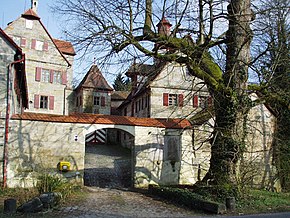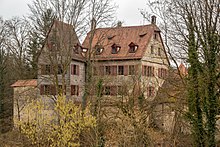Grünsberg Castle
Grünsberg near Altdorf in the Nürnberger Land is a castle complex that dates back to the 13th century and has been expanded into a representative country estate by various Nuremberg patrician families since the 16th century.
history
Grünsberg Castle
Grünsberg Castle is located in a depression on a ridge that slopes down to the Schwarzach, the mountain at bottom . That a defensive tower from the time of the Hungarian invasions around 945 originally stood at this point is a pure hypothesis for which there is no tangible evidence.
The fortified seat was built on imperial property before 1231, probably on behalf of the empire . The Reichsministeriale Albertus Rindesmule de Nurnberch was enfeoffed with the castle and called himself in 1231 Rindesmule de Grundisperc . It is not certain whether he was involved in the construction. From the legacy of the last Staufer Konradin , the imperial fiefdom came to Ludwig the Strict of the Wittelsbach family ; the property remained with the Rindsmaul.
In 1311 the castle was pledged to the brothers Albrecht, Marquart and Hartmann Rindsmaul by Ludwig the Bavarian as feudal lord for 350 pounds of Heller. Of the loan amount, £ 250 had already been paid out, and a further £ 100 was to be built on Grünsberg. In view of the chronic financial shortage of their liege lords, free ownership of the castle seemed within reach for the Rindsmaul. In 1315, regardless of the claims of Rindsmaul, Ludwig transferred the lien on the castle to her brother-in-law, the well-known knight Seyfried Schweppermann . This had helped him decisively to victory in the battle of Gammelsdorf . The pledge of Schweppermann as "heirs" of Rindsmaul was confirmed in 1375 by Count Palatine Ruprecht and his successors.
After the Schweppermanns died out, the Freudenbergers took over the castle in 1433, which was besieged and damaged by Nuremberg troops in the First Margrave War . In 1481 the Truchseß von Pommersfelden , who were in the service of the Wittelsbachers, followed. During the Landshut War of Succession , the castle was burned down by Nuremberg troops and fell to the imperial city of Nuremberg in 1504 . In 1506 they leased the entire estate to the Nuremberg merchant Wilhelm Rauscher. The latter later ceded the property to his creditor Hans Durnhöfer and finally had to return it to the city council in 1518 due to insolvency. In 1529 the Nuremberg patrician Friedrich Behaim bought the entire estate for 3000 guilders and undertook to open the castle to the city council of Nuremberg and to sell or bequeath it exclusively to Nuremberg citizens. However, the Behaim only carried out partial renovations, and the castle was still in ruins before the fire damage in the Second Margrave War of 1552. In 1556 the Erbare family Oertel acquired the property and rebuilt the castle; since then the property has always been passed on to this day. The repair of the damage from both wars dragged on for several years. In 1561 the three-storey main bower was completed.
After the Örtel, Nuremberg patrician families took turns as owners. In 1579 the son-in-law Sigmund Haller von Hallerstein inherited the castle. After his death in 1672 she inherited his son-in-law Johann Paul II. Paumgartner von Holnstein, whose family subsequently called themselves Paumgartner von Holnstein and Grünsberg .
Grünsberg Castle
The extension of the castle to a palace complex took place in the period from 1717 to 1723 under the last member of the Paumgartner patrician family, Johann Paul III. Paumgartner. The complex also received its significant stucco ceilings, the stair tower on the main building, the tower on the northeast corner, then in 1723 the gatehouse to the main castle and finally the buildings in the outer castle. Even if Paumgartner undertook fundamental alterations, it is astonishing that he always retained the basic shape of the medieval castle - quite atypical for the architectural preferences of his time - and even expanded it in part in an obviously historicizing way . Outside the castle, a baroque garden was created in front of the south wall, which is now badly damaged and therefore cordoned off, the Sophienquelle and the straight avenue leading to it. The sky garden was redesigned in Baroque style and given an orangery, which has now disappeared. Around 1730 Johann Paul married Paumgartner's widow, Sophie Paumgartner, b. Useful from Sündersbühl , a Haller. From 1730 to 1766 Grünsberg was again owned by the Haller von Hallerstein family .
In 1754 Sophie's daughter from her second marriage, Eleonore Haller von Hallerstein, married Karl Christoph Stromer von Reichenbach . In 1766 Sophie left Grünsberg to her son-in-law (and Schloss Holnstein in the district of Amberg-Sulzbach, sold again in 1813), who took over her high debts in return. Since then, Grünsberg Castle has been owned by the Stromer family, one of the oldest and most important patrician families in Nuremberg. In the years 1909–1912 and 1919–1923 the castle was extensively renovated. By 1954, the damage caused by the Second World War in the forecourt of the palace was poorly repaired. Comprehensive renovation measures followed from 1990.
The building has been designated as an architectural monument (D-5-74-112-157) and ground monument (D-5-6633-0155) by the Bavarian State Office for the Preservation of Monuments .
inventory
In Grünsberg Castle there is an extremely valuable "inventory of objects that are culturally and historically closely linked to the imperial city of Nuremberg, which span the 13th to 20th centuries and, from a historical and art-historical point of view, in their entirety - represent a unique outline of patrician self-image and living conditions through the Represent centuries ". In addition to countless historical everyday objects and furniture, qualitative portraits, Nuremberg death shields and valuable glass goblets, a special feature is a contemporary construction model of the Venetian Rialto Bridge from the 1580s, which was probably in the possession of Wolf Jacob Stromers, the builder of the Nuremberg meat bridge. Whether this model was actually used for the construction of the meat bridge is still controversial. The so-called moon glass panes, from which v. a. have received some on the second floor of the Palas. According to the inscription, the late medieval portable altar by the council builder Endres Tucher , which contains several tiny relic pouches, was consecrated by the Archbishop of Acre .
Stromer cultural property, monument and nature foundation
The last owner of Grünsberg Castle, Wolfgang Stromer von Reichenbach , set out in his legacy the conversion of the property and castle into a public, non-profit foundation under civil law. This was implemented in 2000 in order to preserve this nationally significant monument with its precious inventory for posterity and to make it accessible to the public as much as possible. Since the death of her father, Rotraut Freifrau von Stromer-Baumbauer has been responsible for the renovation work as administrator of the Stromer Foundation for Cultural Assets, Monuments and Nature. Benefit concerts have been taking place in the courtyard and in the small concert hall in the former castle chapel since 2003, the proceeds of which are used for the renovation work. On July 10, 2006, the support association Burg Grünsberg e. V. founded. Grünsberg Castle can be visited with a guide on certain Sundays or by appointment. In 2009 the Electricity Foundation was awarded the Bavarian Monument Protection Medal for the general renovation of Burg Grünsberg , and in 2010 it was awarded the Silver Hemisphere, the most important award of this kind at national level.
Surroundings
In the vicinity of Grünsberg Castle is the Sophienquelle , the largest enclosed baroque spring system north of the Alps (built on the Italian model in 1724-26 by Johann Paul Paumgartner in honor of his wife Sophie Usefulel von Sündersbühl ), which is also part of the Stromer cultural property, monument and nature foundation must be preserved. The entire complex also includes a baroque tithe barn , which adjoins the Renaissance Baroque garden known as the Himmelgarten with originally seven terraces, which is now used as a pet cemetery. The foundation also manages the surrounding forest, which was included in the EU's FFH list in 2004 as particularly worthy of protection, with the Rhätsandsteinschlucht Teufelskirche .
See also
literature
- Robert Giersch, Andreas Schlunk, Berthold Frhr. von Haller: Castles and mansions in the Nuremberg countryside. Altnürnberger Landschaft, Lauf an der Pegnitz 2006, ISBN 3-00-020677-9 , pp. 152–156.
- Carl Adam: Archive of the Barons Stromer von Reichenbach at Grünsberg Castle. Part II: Files. Degener, Neustadt ad Aisch 1972, issue 34.
- Jasmin Horrelt: The sky garden in Grünsberg. A historic castle park in Middle Franconia. In: Altnürnberger Landschaft . No. 45, 1996, pp. 88-99.
- Erich Odörfer: Herrschaft Grünsberg. The development of the former rule Grünsberg and its localities 1231–2003. Altdorf 2003 (= Altnürnberger Landschaft eV Mitteilungen, 52nd year, issue 1).
- Ina Schönwald: Studies on the Paumgartner patrician family at Grünsberg Castle. Reflections on the self-image of the Nuremberg patriciate in the first third of the 18th century (= series of publications by the Altdorf City Archives. ) Lauf 2002.
- Wolfgang Stromer von Reichenbach: The Sophienquelle in the Schlosspark zu Grünsberg in the Nuremberg region, built 1724–28, rebuilt in 1860 a. 1979. Edited by the Altnürnberger Landschaft eV Korn u. Berg, Nürnberg 1980, ISBN 3-87432-064-2 . (Communications of the Altnürnberger Landschaft eV, year 29th 1980, issue 1)
- Matthias Thiel: Archive of the Barons Stromer von Reichenbach at Grünsberg Castle. Part I: Certificates. Degener, Neustadt ad Aisch 1972. (Bavarian archive inventories. Middle Franconia series. Issue 8).
Web links
- Grünsberg Castle - Art, history and culture in the Nürnberger Land in the online magazine Kunstnürnberg
- Grünsberg Castle on the castles and manors side in the Nuremberg countryside
- Stromer cultural property, monument and nature foundation
- Grünsberg Castle on burgseite.de
swell
- ↑ Seyfried Schweppermann ( Memento of July 24, 2004 in the Internet Archive ) (PDF; 39 kB).
- ↑ Ina Schönwald: Studies on the Paumgartner patrician family at Grünsberg Castle…. 2002, pp. 27-28.
- ↑ Stefan Mühlbaur: The restoration of the castle Grünberg. “It's not about beauty”. In: Nürnberger Zeitung. No. 190 of August 17, 2006, p. 15.
- ↑ Natura 2000 leaflet on the FFH area Stromerwald (PDF; 325 kB).
Coordinates: 49 ° 22 ′ 17 ″ N , 11 ° 19 ′ 38 ″ E






